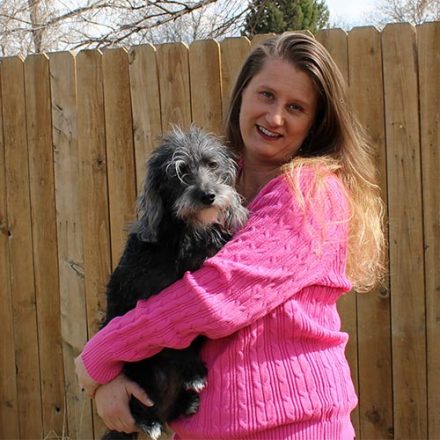A dog’s tail does a lot for him. Tails are more than just another adorable part of your pup. Canine tails help keep their balance, aid in movement and are even used in communication. Have you ever watched your pup run and play? If you focus on his tail, you will see that it helps him steer and change directions. The tail also keeps him from falling or tumbling when he is running. In fact, the tail acts as a counterbalance for your pup any time he moves!
Tails also add to a dog’s overall appearance and give that extra bit of cuteness. Not all tails are the same. We are going to focus some attention on the curly tail and the breeds that have them. The curly or screw tail that many breeds of dogs have is formed by genetics.
Dog’s tails are the very last part of their spine and are made up of vertebrae. In dogs with corkscrew tails, these vertebrae have fused together, and it is called hemivertebrae. This creates a wedge or curly shape. Some dog breeds with straight tails can develop spine issues as they age, which may also cause a tail to curve.
Our Favorite Breeds With Curly Tails
Not all curly tails are created equally. Some breeds have curly, fluffy tails, and others have a small corkscrew tail. Other breeds have tails that curl over their backs towards their heads. Corkscrews can make a full circle on a dog’s back, a half-circle, a double curl, or extend like a plume towards their heads.
Akita & American Akita

The Akita is a gorgeous breed known for its curly, fluffy tail. This large breed originated in Japan in the 17th century and is a member of the Spitz family. In Japan, the Akita is revered and known to symbolize health, happiness, protection, and long life. Many dog lovers will remember the story of Hachiko, the beloved pup from the 1920s who waited every day to greet his owner at the train station for nine years after he died.
Akitas are a large, muscular breed known for their double coats, screw tails, and giant heads. They have a strong personality and need a family that can enforce rules. Akitas reach anywhere from 70 to 130 pounds when fully grown and live about 10 to 13 years. Their fluffy, curled tail helps to keep their noses warm in wintry weather.
There are two types of Akita, Japanese, often called Akita Inu, and American Akita. They are similar types of canines, and in the United States, they are considered to be the same breed. In other countries, they are considered different breeds. Both are fiercely loyal, independent, and confident. The American Akita is slightly larger, bulkier, and more muscular than the Akita Inu. American Akitas have a range of coat colors. Japanese Akita Inus are only found in red, white, or brindle.
Alaskan Malamute
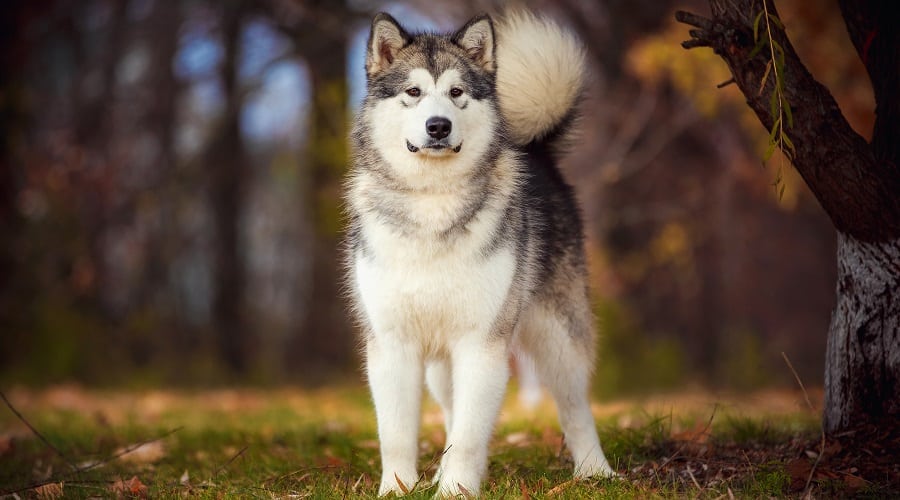
The Alaskan Malamute is well known for its physical appearance and similarities to a wolf. Malamutes have long, double coats with wolf-like markings. This dog is a descendant of the wild wolves of northwestern Alaska. This breed is large, weighing anywhere from 70 to 90 or more pounds. They can live 10 to 14 years.
Despite their generous size and wild looks, the Malamute is a friendly, sociable pup that makes a great family pet. They are not aggressive, despite looking formidable, and are known to be dogs that crave attention and do not like to be alone.
Malamutes have furry curved tails that can cover their faces to stop the cold, wind, and snow. They can have blue, black, white, gray, silver, red, sable, seal, and agouti coats. Because of their large size and long, double coats, Malamutes need more care than some other dog breeds.
American Eskimo Dog

An American Eskimo dog is a breed with a curly tail known for a distinctive white, fluffy coat. They have curved, fluffy tails. These dogs look like smaller versions of another breed, the Samoyed. There are three sizes: standard, miniature, and toy.
Despite what the name implies, these dogs did not originate with the indigenous Eskimo people. They are of German origin and are descendants of the German Spitz breed. This breed often goes by the nickname Eskie or Eskies.
Basenji

The Basenji is a breed from Africa and is known for being a “barkless” canine. Basenjis are an ancient breed and are classified as hounds. They have almond-shaped eyes, tall ears, short, smooth coats, long legs, and tightly curled tails. Their coats can be black, red, brindle, or black and tan. White markings on both their feet and legs are common in all coat colors.
Basenjis are medium-sized dogs and will weigh anywhere from 20 to 24 pounds. They are highly energetic, very affectionate, and full of energy. This breed is very smart and can have stubborn streaks, making them a challenge to train. These dogs have been referred to as “cat-like” due to their quiet nature and a tendency to lick and groom themselves. Basenjis also like to climb, adding to the feline comparison.
Bulldogs

Bulldogs are one kind of dog that can have tails of various types. This includes the curly corkscrew tail often found on English Bulldogs. English Bulldogs can be medium to generous sized. They weigh from 40 to over 60 pounds when fully grown. These dogs live for about 8 to 10 years. Bulldogs have shorter, sleek coats that do not shed a lot. These coats range in colors and include brown, white, brindle, cream, red, fawn, and even spotted.
They have small, flat faces and often have an underbite giving them a pouty look. Despite the tough exterior and bad reputation they often get, bulldogs are very loyal and friendly. They make excellent family pets. English Bulldogs can also be very stubborn and independent, making them hard to train.
Chihuahua
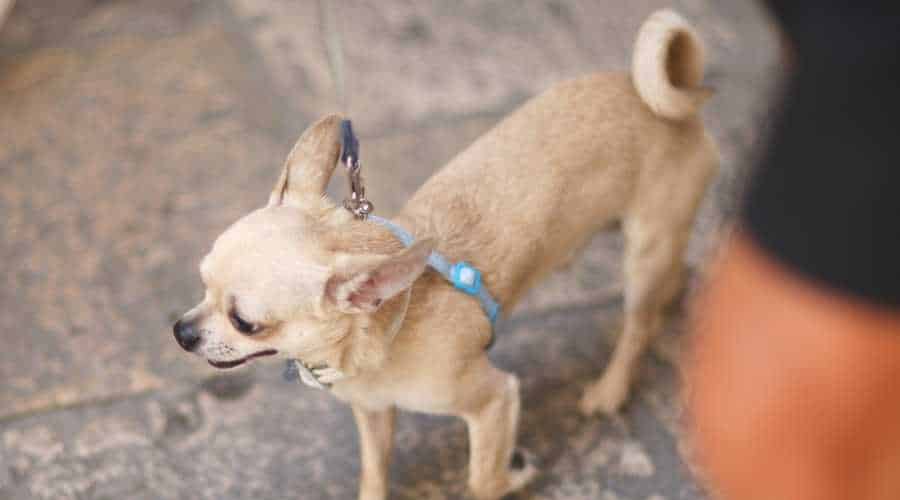
The smallest dog breed in the world, Chihuahuas, can have corkscrew tails. Not all do. Some have straight tails. This will depend on the genetics of each dog. This breed has been traced back to a now-extinct ancestor, the Techichi, that lived in South America.
Chihuahuas are the definition of tiny, full-grown they reach 6 to 10 pounds. These little guys have long lifespans and can live 14 to 16 years. Chihuahuas can have long or short hair, and their coats can be any range of colors. Their tails can be straight, slightly curved, or very curly.
They love their humans and demand a lot of attention. They are well known for their loud, yippy bark, which they use a lot. Curiosity is a big part of the Chihuahua’s character, and they can get themselves into trouble if left unsupervised for too long. These little bundles of energy are great with children and make good pets for families, especially in smaller homes.
Chow Chow
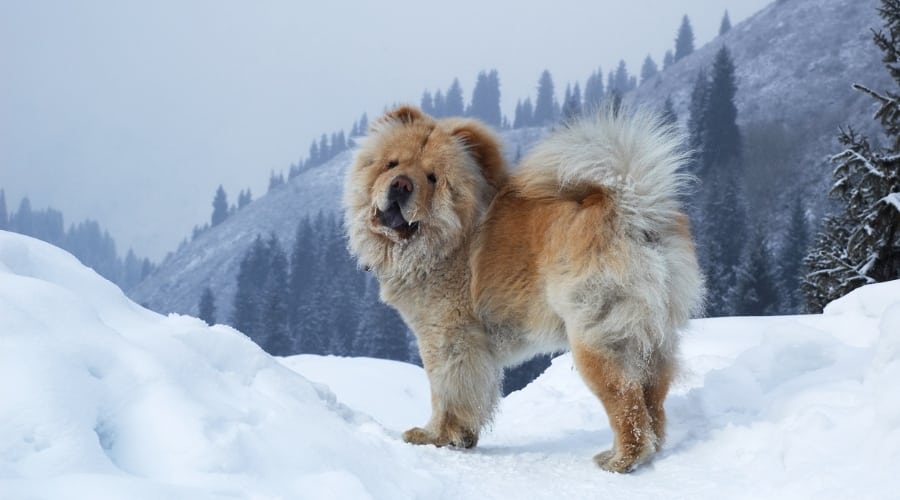
The Chow Chow is a breed famous for its bushy, wild coat. Chows are revered animals in Chinese history and appear in artifacts that date back to China’s Han Dynasty (around 00 B.C). Throughout Chinese history, they have been depicted in art and other artifacts as solid protectors.
Chows have a curved, bushy tail, a plumage that adds to their overall regal stature. Coats can be in a range of colors. Purebred Chows will sport black, blue, cream, red, and cinnamon coats. Chows are solid-colored with lighter fur on the ruff and tail.
A medium-sized breed, Chows weigh about 45 to 70 pounds and stand 17 to 20 inches tall. The lifespan for Chow Chows is 8 to 12 years. These dogs love people and crave affection, but they are not super friendly to strangers. They are affectionate when they want to be and are known as one of the more dominant canine breeds.
Finnish Spitz

The Finnish Spitz is a breed of dog that looks much like a fox with a curved, bushy tail. This small hunting dog originated in Finland and is the country’s national dog. They are popular hunting dogs even today. They are known for being loud barkers and will only get noisier if left alone. These dogs are super friendly and are not aggressive, though they will bark at almost anything they see.
These little dogs are red and have pointy ears and faces, making them look similar to foxes. They weigh 23 to 36 pounds as adults. Coat color can range from red to honey and red-colored. These dogs shed a lot and need to be brushed regularly to keep their coats healthy.
Keeshond

The Keeshond is a breed of dog from the Netherlands that looks like a cross between a Chow and a Husky. This furry, sturdy dog has a double coat of fur and a tightly curled, plume-like tail. Keeshond’s coats are usually gray, cream, and black.
The Keeshond is a rare breed, a variation of the German Spitz, part of the Spitz family of bushy, curly-tailed dogs. These medium-sized canines reach about 35 to 45 pounds and stand over a foot tall from paw to shoulder. They live an average of 12 to 15 years.
Due to the fluffy coat, they may look big but are not great guard dogs. This breed is more likely to lick someone who comes in unannounced than to bark or bite.
Pomeranian

Tiny yet mighty, the Pomeranian is another favorite small doggie with a tail that curves. These little fluff balls only reach 3 to 7 pounds and stand just 6 to 7 inches. They live 12 to 16 years on average. This breed originates from an area once known as Pomerania. This geographical area is now known as northeast Germany and west Poland.
Pomeranians have a lot of sass and attitude, and they want to be the boss all the time. They need a lot of supervision due to their small stature. It is easy for them to slip through small openings or become prey to big birds and wildlife. These pups come in all sorts of colors and often have more than one shade in their fur.
Pug

Immediately recognizable for cute, wrinkled faces paired with a corkscrew tail, Pugs are one of the most well-known curly-tailed dog breeds. Some Pugs will have a double curled tail, and all have at least one curl.
Pugs weigh about 14 to 18 pounds fully grown and stand 10 to 13 inches high. They live 13 to 15 years and are favorite family pets. Pugs are very friendly and tolerant of children and their small size, making them extremely popular for families with kids.
Samoyed
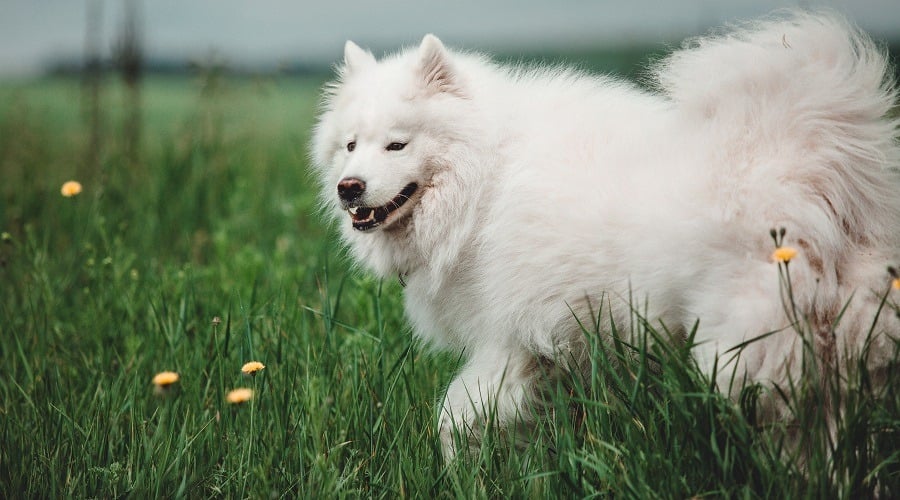
Samoyeds are one incredibly fluffy pup. They hailed from Siberia and were bred for their thick warm coats. This breed uses his fluffy, thick tail to curl up and over his face when the weather is cold. Samoyeds are medium-sized dogs, about 35 to 65 pounds. They stand 19 to 24 inches from paw to shoulder. These dogs live an average lifespan of 12 to 14 years.
Samoyed dogs are well known for their light, pearly coats and their sweet expressions. They often look as though they are smiling and have a great disposition. This breed loves humans and craves attention, making them needy at times. They are an excellent breed for families and are very tolerant of children.
Shiba Inu

The Shiba Inu is another curly-tailed canine breed that comes from Japan. Called the most popular native Japanese canine breeds, they have been a family favorite for generations. The Shiba Inu is a smaller breed weighing about 17 to 23 pounds when fully grown. This breed lives for about 13 to 16 years.
This breed has a fluffy, shorter coat with a screw tail. The hair on their tails is longer than on their faces and the rest of their bodies. They have sleek coats of cream, black and tan, red, and sesame with white or cream-colored markings.
Shiba Inus are independent, attentive, and vigilant dogs. This pup can be challenging to train for inexperienced dog owners due to their assertiveness. They are not as active dogs as some other breeds and do well indoors.
Siberian Husky

The beloved and beautiful Siberian Husky is one of the most well-known breeds with an impressive curly tail. This breed looks remarkably close to a wolf and has a bushy curved tail that arches over their back. They are a smaller cousin of the Alaskan Malamute. These dogs are highly energetic, intelligent, and friendly.
Huskies are medium to large and can reach 35 to 60 pounds when fully grown. They stand 20 to 24 inches tall, paw to shoulder. This breed lives for 12 to 14 years. Their sleek, luxurious coats can be white, black, brown, grey, red, sable, or agouti.
Tibetan Mastiff

One of the giant dog breeds, the Tibetan Mastiff, is an impressive dog. This rare dog breed originated in Tibet many centuries ago. They require exceptional and specialized care, as do all giant breeds of dogs.
The Tibetan Mastiff is a giant breed with a double outer coat of black, brown, bluish-gray, and gold. They are incredibly fluffy, with huge, curved tails that stretch back towards their heads. This breed is expected to live for about 10 to 12 years.
These giant dogs make excellent guard dogs as well as companions. Tibetan Mastiffs are loyal, intelligent, and can be very stubborn. They may need special training and must be watched carefully to ensure they do not overdo it physically. This breed is also susceptible to some health conditions due to their enormous size. These include hip dysplasia, hypothyroidism, progressive retinal atrophy, and elbow dysplasia.
Similarities
Many of the curly-tailed dog breeds we mentioned hail from the Spitz family of dogs. These include the Pomeranian, Samoyed, Siberian Husky, Malamute, Keeshond, Akita, Chow, Chow, Shiba Inu, Finnish Spitz, American Eskimo dog, and more. These breeds all have tails that curl over their backs.
Several dog breeds with screw tails have thick, long coats and curly tails that can be used to keep their faces warm when curled up.
These dog breeds are all purebred. Many mixed breeds also have corkscrew tails. Genetics plays a role in the kind of tail dogs will have, so different combinations will result in many variations of the curly canine tail.
Frequently Asked Questions
Are curly tails on dogs a sign of disease?
While some diseases and health conditions can come with a corkscrew tail, a tail that is curled is not usually a sign of disease. If your dog’s tail suddenly changes, or you have concerns about his spine or tail health, contact your veterinarian to check in on him and learn more.
What causes a curly tail?
Curly tails in dogs are a result of genetics. They are the result of a deformity called hemivertebrae. When this happens, the vertebrae in the tail fuse together, creating a curve.
Does a curly tail mean my dog has a curved spine?
A corkscrew tail does mean your dog has a curved spine. However, this does not mean anything is wrong. The tail is an extension of the spine, and if your dog starts experiencing weakness in his back limbs or other issues, you should consult with your vet. A curly tail does not automatically mean your dog will have spine problems. A lot goes into his care and health, all of which can affect canine spine health.
Final Thoughts
A dog’s tail is an essential part of his body. Tails both add physical character and cuteness to a dog’s body. They also serve significant purposes. Tails help a dog’s balance, serve as a way of steering, help them communicate, and act as protection against the weather.
Corkscrew tails are a normal part of the anatomy for many specialized breeds of dogs. Many of our favorite breeds have very curly or slightly curly tails. The 15 breeds we mentioned are far from the only dog breeds with screw tails. However, they are some of the all-time favorites.
